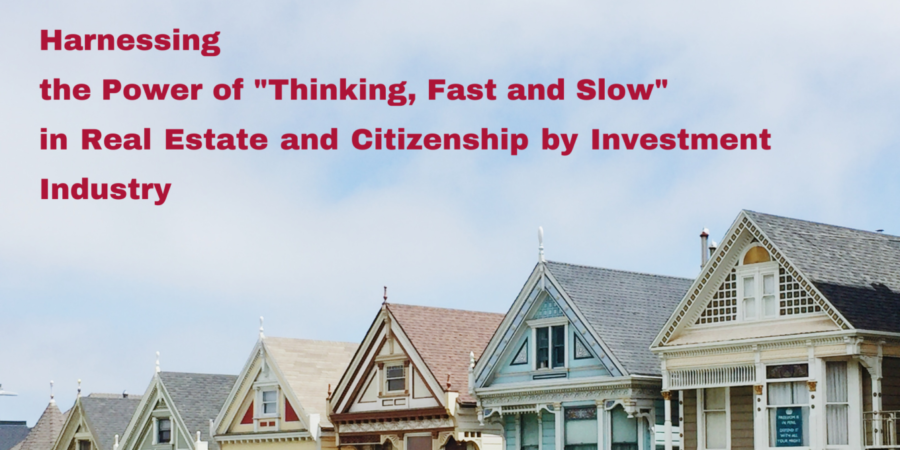Harnessing the Power of Thinking Fast and Slow in Real Estate and Citizenship by Investment Industry
Introduction
In his groundbreaking book “Thinking Fast and Slow,” Nobel laureate Daniel Kahneman explores the intricacies of human decision-making, shedding light on the different ways our minds process information. His work examines the dual process of thinking – System 1, which is fast and intuitive, and System 2, which is slow and analytical. Understanding the key takeaways from Thinking Fast and Slow can provide valuable insights for professionals in the real estate and citizenship by investment industry, helping them make better decisions and achieve greater success.

Understanding the Dual Process of Thinking
System 1: Fast and Intuitive
System 1 represents our immediate, instinctive reactions to situations. It operates automatically and quickly, with little or no conscious effort. This system often relies on heuristics, or mental shortcuts, to quickly process information. While this can be helpful in certain situations, it can also lead to cognitive biases and errors in judgment.
System 2: Slow and Analytical
System 2 is the more deliberate and analytical part of our thinking process. It requires conscious effort and can handle more complex tasks, such as problem-solving and critical thinking. Although it is slower, System 2 is better equipped to make well-informed decisions.

Overcoming Cognitive Biases in Real Estate
Anchoring Bias
Anchoring bias occurs when individuals rely too heavily on an initial piece of information, known as the “anchor,” when making decisions. For real estate professionals, this can manifest when evaluating a property’s worth based on the initial listing price or a comparable property’s value. To overcome this bias, it is crucial to conduct thorough research and consider a range of factors when determining a property’s value.
Confirmation Bias
Confirmation bias leads individuals to seek information that confirms their preconceptions while ignoring or downplaying conflicting evidence. Real estate professionals may fall into this trap when they search for information to validate their beliefs about a property’s potential. To combat this bias, it is essential to actively seek out and consider opposing viewpoints or information that contradicts one’s initial beliefs.

Enhancing Decision-Making in Citizenship by Investment
Loss Aversion
Loss aversion refers to the tendency for individuals to prefer avoiding losses rather than acquiring gains. In the context of citizenship by investment, this may lead potential investors to overemphasize the risks involved, while downplaying potential benefits. To address loss aversion, professionals should provide comprehensive information about both the risks and rewards of citizenship by investment programs, helping clients make informed decisions.
Availability Heuristic
The availability heuristic causes individuals to overestimate the likelihood of events based on their availability in memory. For citizenship by investment professionals, this may result in potential investors fixating on high-profile cases of fraud or negative outcomes, skewing their perception of the industry. To counteract this bias, it is important to present a balanced perspective and provide accurate information about the overall success and benefits of these programs.

Implementing “Thinking Fast and Slow” Principles for Success
Encourage System 2 Thinking
By fostering a culture that encourages critical thinking and thorough analysis, real estate and citizenship by investment professionals can make better-informed decisions. This may involve conducting in-depth research, considering multiple perspectives, and engaging in open discussions with colleagues and clients.
Recognize and Address Cognitive Biases
Being aware of cognitive biases and actively working to overcome them can significantly improve decision-making. Professionals should continuously educate themselves on common biases and implement strategies to mitigate their impact on their work.
Conclusion
In conclusion, the principles outlined in Daniel Kahneman’s “Thinking Fast and Slow” can be instrumental in improving decision-making processes within the real estate and citizenship by investment industries. By recognizing the dual nature of human thinking and embracing the strengths of both System 1 and System 2, professionals can make more informed, strategic decisions that benefit their clients and their businesses. Encouraging critical thinking and thorough analysis, while acknowledging and addressing cognitive biases, can lead to better outcomes for all stakeholders involved.
Furthermore, staying informed about the latest research in decision-making and cognitive biases can help professionals stay ahead of the curve and continuously improve their practices. To gain deeper insights, professionals may consider reading the following resources:
- Kahneman, D. (2011). Thinking, Fast and Slow. Farrar, Straus, and Giroux.
- Tversky, A., & Kahneman, D. (1974). Judgment under Uncertainty: Heuristics and Biases. Science, 185(4157), 1124-1131.
- Gilovich, T., Griffin, D., & Kahneman, D. (Eds.). (2002). Heuristics and Biases: The Psychology of Intuitive Judgment. Cambridge University Press.
By incorporating these principles into their daily work, real estate and citizenship by investment professionals can enhance their decision-making skills and ultimately provide superior services to their clients. By fostering a culture of continuous learning and growth, these industries can continue to thrive and adapt to an ever-changing global landscape.




